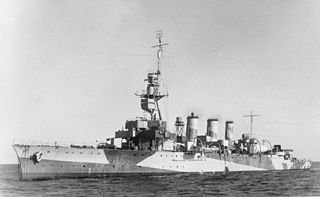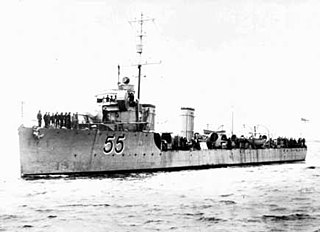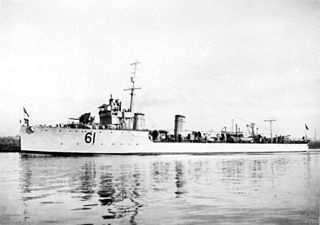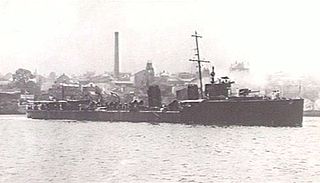
HMAS Adelaide was a Town-class light cruiser of the Royal Australian Navy (RAN), named after Adelaide, the capital city of South Australia. Laid down in 1915, wartime shortages and design modifications meant the ship was not completed until 1922, earning her the nickname "HMAS Longdelayed".

HMAS Encounter was a second-class protected cruiser of the Challenger class operated by the Royal Navy (RN) and Royal Australian Navy (RAN). She was built by HM Dockyard Devonport and completed at the end of 1905.

HMAS Psyche was a Pelorus-class protected cruiser built for the Royal Navy at the end of the 19th century. Initially operating on the North America and West Indies Station, the cruiser was transferred to the Australian Squadron in 1903, and remained there until the Royal Australian Navy (RAN) took over responsibility in 1913. After a stint in New Zealand waters and involvement in the Occupation of German Samoa, Psyche was paid off in 1915.

HMAS Parramatta, named after the Parramatta River, was a River-class torpedo-boat destroyer of the Royal Australian Navy (RAN). Ordered in 1909 for the Commonwealth Naval Forces, Parramatta was the first ship launched for the RAN. Temporarily commissioned into the Royal Navy for the delivery voyage to Australia, the destroyer came under Australian naval control in 1910, and was recommissioned into the RAN on 1 March 1911, shortly before the latter's formal creation.

HMAS Swan was a River-class torpedo-boat destroyer of the Royal Australian Navy (RAN). One of six built for the RAN, Swan was built at Cockatoo Island Dockyard, and entered service in 1916. The early part of the ship's career was spent on blockade duty in the Far East, before she was transferred to the Mediterranean for anti-submarine duty. Apart from performing shore bombardment during the Second Battle of Durazzo, Swan's wartime career was uneventful. The destroyer was placed in reserve in 1920, but was reactivated between 1925 and 1927 and assigned to Tasmania. Swan was decommissioned in 1928, stripped of parts, and sold for use as prisoner accommodation on the Hawkesbury River. After changing hands several times, the hull sank during gale conditions in 1934.

HMAS Sydney was a Chatham-class light cruiser of the Royal Australian Navy (RAN). Laid down in 1911 and launched in 1912, the cruiser was commissioned into the RAN in 1913.

HMAS Sydney, named after the Australian city of Sydney, was one of three modified Leander-class light cruisers operated by the Royal Australian Navy (RAN). Ordered for the Royal Navy as HMS Phaeton, the cruiser was purchased by the Australian government and renamed prior to her 1934 launch.

HMAS Hobart was a modified Leander-class light cruiser which served in the Royal Australian Navy (RAN) during World War II. Originally constructed for the Royal Navy as HMS Apollo, the ship entered service in 1936, and was sold to Australia two years later. During the war, Hobart was involved in the evacuation of British Somaliland in 1940, fought at the Battle of the Coral Sea and supported the amphibious landings at Guadalcanal and Tulagi in 1942. She was torpedoed by a Japanese submarine in 1943, then returned to service in 1945 and supported the landings at Tarakan, Wewak, Brunei, and Balikpapan. Hobart was placed in reserve in 1947, but plans to modernise her and return her to service as an aircraft carrier escort, training ship, or guided missile ship were not followed through. The cruiser was sold for scrapping in 1962.

HMAS Australia was one of three Indefatigable-class battlecruisers built for the defence of the British Empire. Ordered by the Australian government in 1909, she was launched in 1911, and commissioned as flagship of the fledgling Royal Australian Navy (RAN) in 1913. Australia was the only capital ship ever to serve in the RAN.

HMAS Brisbane was a Town class light cruiser of the Royal Australian Navy (RAN). Built in Sydney between 1913 and 1916 to the Chatham subtype design, Brisbane operated in the Indian Ocean, Pacific Ocean, and Australian coastal waters during World War I.

HMAS Canberra (I33/D33), named after the Australian capital city of Canberra, was a Royal Australian Navy (RAN) heavy cruiser of the Kent sub-class of County-class cruisers. Constructed in Scotland during the mid-1920s, the ship was commissioned in 1928, and spent the first part of her career primarily operating in Australian waters, with some deployments to the China Station.

The Battle of Cocos was a single-ship action that occurred on 9 November 1914, after the Australian light cruiser HMAS Sydney, under the command of John Glossop, responded to an attack on a communications station at Direction Island by the German light cruiser SMS Emden, commanded by Karl von Müller.

HMAS Yarra, named for the Yarra River, was a River-class torpedo-boat destroyer of the Royal Australian Navy (RAN). Ordered in 1909 for the Commonwealth Naval Forces, Yarra was temporarily commissioned into the Royal Navy on completion in 1910 and handed over to Australian control on arrival in Australia.

HMAS Torrens, named for the River Torrens, was a River-class torpedo-boat destroyer of the Royal Australian Navy (RAN). The destroyer was built at Cockatoo Island Dockyard and entered service with the RAN in 1916. The destroyer was first deployed to East Asia, then the Mediterranean, where she remained for the rest of World War I. After returning to Australia, the destroyer was decommissioned, but saw use in several ports for reservist training before the decision to sell her for scrap was made. After being stripped, the destroyer was towed outside Sydney Heads, used for gunnery practice, and scuttled.

HMAS Huon (D50), named after the Huon River, was a River-class torpedo-boat destroyer of the Royal Australian Navy (RAN). Originally to be named after the River Derwent, the ship was renamed before her 1914 launch because of a naming conflict with a Royal Navy vessel.

HMAS Warrego, named for the Warrego River, was a River-class torpedo-boat destroyer of the Royal Australian Navy (RAN). Ordered in 1909, construction of the destroyer started in England, but she was then broken down and reassembled at Cockatoo Island Dockyard in order for the Australian shipbuilding industry to gain experience in warship construction. Warrego was commissioned into the RAN in 1912, and spent her early career operating in Australian waters.

HMS Pegasus was one of 11 Pelorus-class protected cruisers ordered for the Royal Navy in 1893 under the Spencer Program and based on the earlier Pearl class. The class were fitted with a variety of different boilers, most of which were not entirely satisfactory, and by 1914, four ships had been withdrawn. They had all been condemned in 1904 but were reprieved and remained in service, with scrapping proposed in 1915.

The history of the Royal Australian Navy traces the development of the Royal Australian Navy (RAN) from the colonisation of Australia by the British in 1788. Until 1859, vessels of the Royal Navy made frequent trips to the new colonies. In 1859, the Australia Squadron was formed as a separate squadron and remained in Australia until 1913. Until Federation, five of the six Australian colonies operated their own colonial naval force, which formed on 1 March 1901 the Australian Navy's (AN) Commonwealth Naval Force which received Royal patronage in July 1911 and was from that time referred to as Royal Australian Navy (RAN). On 4 October 1913 the new replacement fleet for the foundation fleet of 1901 steamed through Sydney Heads for the first time.
HMAS Medea was an auxiliary minesweeper of the Royal Australian Navy (RAN) between 1942 until 1946. Built in 1912 for the Ocean Steam Ship Co. she was sold to the Straits Steam Ship Co. in 1925. She was requisitioned by the Royal Navy in 1939 and converted into an auxiliary minesweeper and named HMS Circe. She was transferred to the Royal Australian Navy in 1942 and renamed HMAS Medea until she was returned to her owners in 1946. She was sold and was scuttled off Sydney on 20 January 1948.

HMAS Mercedes was an auxiliary minesweeper of the Royal Australian Navy (RAN) between 1942 until 1946. Built in 1913 for the Ocean Steam Ship Co. she was sold to the Straits Steam Ship Co. in 1925. She was requisitioned by the Royal Navy in 1939 and converted into an auxiliary minesweeper and named HMS Medusa. She was transferred to the Royal Australian Navy in 1942 and renamed HMAS Mercedes until she was returned to her owners in 1946. She was sold and was scuttled off Sydney on 23 January 1948.




















